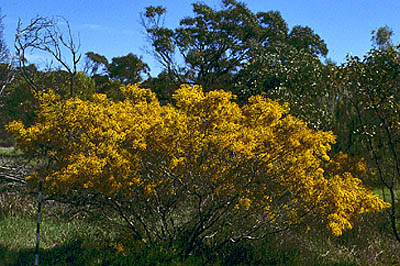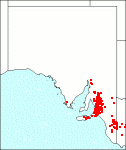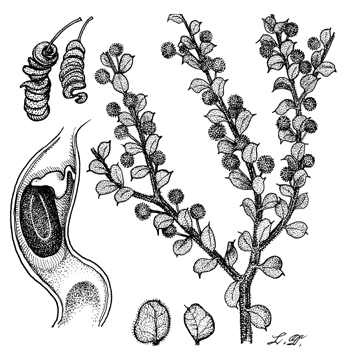Family: Fabaceae
Acacia acinacea

Citation:
Lindley in T. L. Mitchell, Three Exped. Australia, edn. 1, 2: 265 (1836).
Derivation: acinaces (Latin)--a short Persian sword, a reference to the shape of the phyllodes Synonymy: A. obliqua A. Cunn. ex Benth., Hook. Lond. J. Bot. 1:334 (1842) non Desv. 1814; A. rotundifolia Hook., Bot. Mag. 69, t. 4041 (1843); A. cyclophylla Schldl., Linnaea 20:663 (1847)., Acacia latrobei Common name: Gold dust wattle
Description:
Small, straggly, often spindly and rather loosely-branched shrubs to 1.5 m high with short thin stems that divide into rather long slender etching branches; branchlets reddish-brown, usually pubescent slightly angular but soon becoming almost terete, marked with small raised phyllode bases. Phyllodes obliquely obovate or orbicular, 5-14 mm long, flat, more or less pubescent (sometimes quite densely hairy), mucronulate, main vein close to the lower margin and somewhat obscure, usually with a few fainter lateral veins; glands small on the upper margin below middle. Inflorescences simple and axillary solitary or twin; flower-heads globular, bright yellow, c. 10-15-flowered; peduncles slender glabrous usually longer than the phyllodes; flowers 5-merous. Legumes linear, spirally coiled, 2-4 mm broad, mid to dark brown, glabrous or sometimes sparsely hairy; margins yellowish, vein-like. Seeds longitudinal in legume, obloid; funicle short, thickened into a clavate aril.
|
|
Distribution:
|
Northern and Southern Lofty, Kangaroo Island, Flinders Ranges (southern part) and Murray regions, mainly on the western side of the Murray around Sedan, with an isolated occurrence at Loxton (T.R.N. Lothian 1952). Soils; mainly hard acidic or neutral yellow duplex and brown calcareous earths. Rainfall 300-800 mm. Also N.S.W. and Vic.
S.Aust.: FR, NL, MU, SL, KI, SE.
|
Flowering time: May — September. |

SA Distribution Map based
on current data relating to
specimens held in the
State Herbarium of South Australia
|
Biology:
No text
Related taxa:
Acacia glandulicarpa can be confused as to phyllode shape but differs in having two prominent veins, and the legumes covered with glandular hairs. The name Acacia cyclophylla Schltdl. has been applied to specimens with densely pubescent phyllodes but is here treated as a synonym.
Taxonomic notes:
Maslin (1987) discusses the confused nomenclature and allied species of A. acinacea. Description of the new species A. halliana is given (q.v.) and the relationship of A. acinacea to A. imbricata, A. microcarpa and A. triquetra with commentary and maps provided.
Cultivation:
A highly recommended species for ornamental planting forming a compact, spreading, rounded shrub, with long arching branches in cultivation; profusely flowering in spring. Fast growth rate.
Author:
Not yet available
References:
Source:

|

